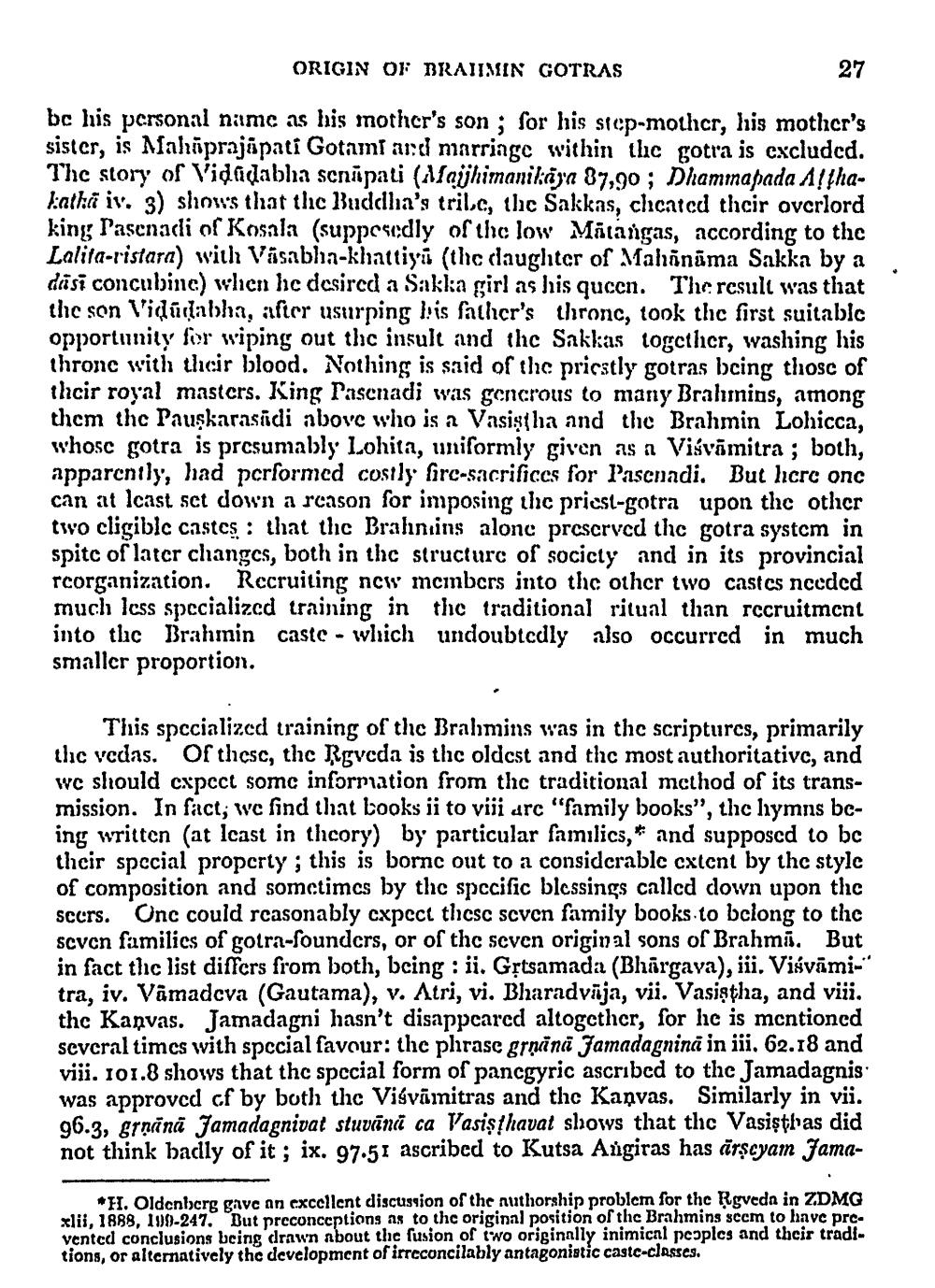Book Title: Origin of Brahmin Gotras Author(s): Dharmanand Kosambi Publisher: D D Kosambi View full book textPage 7
________________ ORIGIN OF BRAIIMIN GOTRAS 27 bc luis personal name as his mother's son ; for his step-mother, his mother's sistcr, is Mahõprajapati Gotami ard marriage within thc gotra is cxcluded. The story of Vidadabha scnipati (najjhimanitāya 87,90 ; Dhammapada Alphafatha iv. 3) shows that thc Buddha's trilc, thic Sakkas, chcatcd thcir overlord king lasenadi of Kosala (supposedly of the low Matangas, according to the Lalita-ristara) with Väsablin-khattiya (the daughter of Mahināma Sakka by a diisi concubinc) vlien hc desired a Sakka girl as his quccn. The result was that the son Vidū labha, after usurping his father's thronc, took the first suitablc opportunity for wiping out thc insult and thc Sakkas together, washing his throne with thcir blood. Nothing is said of the pricstly gotras bcing those of thcir royal masters. King Tascnadi was gcncrous to many Brahnins, among them thc Pauşkarasidi above who is a Vasiştha and the Brahmin Lohicca, whose gotra is presumably Lohita, uniformly given as a Viśvāmitra ; both, apparently, had performed costly firc-sacrifices for Pascnadi. But hcrc onc can at lcast sct down a rcason for imposing the priest-gotra upon the other two cligiblc castes : that thc Brahnıins alonc prcscrved thc gotra system in spitc of later changes, both in thc structurc of socicty and in its provincial rcorganization. Recruiting ncw members into the other two castcs nccdcd much less specialized training in the traditional ritual than recruitment into tlic Brahınin castc - which undoubtedly also occurred in much smaller proportion. This specialized training of the Brahmins was in the scriptures, primarily thic vcdas. Of thesc, thc Roveda is thc oldcst and the most authoritativc, and wc should cxpcct some information from thc traditional mcthod of its transmission. In fact; we find that looks ji to viji arc "family books", thc hymns bcing written (at lcast in theory) by particular familics,* and supposed to be their special property ; this is bornc out to a considerablc cxtent by thc stylc of composition and sometimes by thc spccific blessings called down upon the sccrs. Onc could rcasonably expect thcsc scven family books to bclong to the scvcn families of golra-founders, or of thc scven original sons of Brahmi. But in fact the list differs from both, bcing : ii. Gștsamada (Bhargava), iii. Viśvāmitra, iv. Vamadova (Gautama), v. Atri, vi, Bharadvūja, vii. Vasistha, and viïi. thc Kanvas. Jamadagni hasn't disappeared altogether, for hc is mcntioncd several times with special favour: thc phrasc grņinä jamadagninä in iii. 62.18 and vič. 101.8 shows that the special form of pancgyric ascribed to the Jamadagnis was approved cf by both thc Viśvāmitras and the Kanvas. Similarly in vii. 96.2, crniinä jamadagnivat stuviinit ca Vasisthavat shows that thc Vasisthas did not think badly of it ; ix. 97.51 ascribed to Kutsa Angiras has ärscyam Jama *H. Oldcnbcrg gave an excellent discussion of the nuthorship problem for the Rgvedn in ZDMG xlii, 1888, 199-247. But preconceptions as to the original position of thc Brahmins sccm to have prevented conclusions being drawn about the fusion of two originally inimical peoples and their traditions, or alternatively the development of irreconcilably antagonistic castc-classes.Page Navigation
1 ... 5 6 7 8 9 10 11 12 13 14 15 16 17 18 19 20 21 22 23 24 25 26 27 28 29 30 31 32 33 34 35 36 37 38 39 40 41 42 43 44 45 46 47 48 49 50 51 52 53 54 55 56 57 58 59
